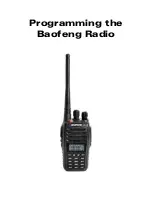
(No.RA035<Rev.001>)1-9
2.3.4 Frequency Synthesizer Unit
2.3.4.1
Frequency synthesizer
The frequency synthesizer consists of the TCXO (X1), VCO, PLL-IC (IC2), and buffer amplifiers.
The TCXO generates 16.8MHz. The frequency stability of TCXO is 2ppm within the temperature range of -30
°
C to +60
°
C. The fre-
quency tuning and modulation of the TCXO are done to apply voltage to pin 1 of the TCXO. The TCXO output is applied to pin 10 of
the PLL-IC.
The VCO consists of 2 VCOs and covers a dual range of 185.95~223.95MHz and 136~174MHz. The VCO generates
185.95~223.95MHz to provide the first local signal for reception. The operating frequency is generated by Q6 in transmitting mode
and Q5 in receiving mode. The oscillation frequency is controlled by applying the VCO control voltage the variable capacitance diodes
(D3,D9,D11,D13 and D17 while transmitting and D4,D8,D12 and D16 while receiving).
The TX/RX pin of IC710 goes “high” in transmission mode, causing Q8 to turn off, and Q7 turn on. The TX/RX pin goes “low” in recep-
tion mode.
The output from Q5 and Q6 are amplified by a buffer amplifier (Q9) and are then sent to the PLL-IC. The PLL-IC consists of an 18-bit
delta signal modulator, prescaler, reference divider, phase comparator, and charge pump.
The input signal from pin 10 and 17 of the PLL-IC is divided down and compared at the phase comparator. The pulse output signal of
the phase comparator is applied to the charge pump and transformed into a DC signal in the loop filter (LPF). The DC signal is applied
to the CV of the VCO and is locked to keep the VCO frequency constant.
PLL data is output from PLL_LE (pin 87), PLL_DATA (pin 86) and PLL_CLK (pin 88) of the MCU (IC710). The data is input to the PLL-
IC when the channel is changed or when transmission is changed to reception and vice-versa. The PLL lock condition is always mon-
itored by pin 71 (PLL_LD) of the MCU. When the PLL is unlocked, PLL_LD goes low.
Fig.6 PLL block diagram
2.3.5 Control Circuit
The control consists of the MCU (IC710) and its peripheral circuits. It controls the Main unit. IC710 mainly performs the following;
(1) Switching between transmission and reception via the PTT signal input.
(2) Reading channel information, frequency, and program data from the memory circuit.
(3) Sending frequency program data to the PLL.
(4) Controlling squelch on/off via the DC voltage from the squelch circuit.
(5) Controlling the audio mute circuit via the decode data input.
(6) Transmitting tone and encode data.
2.3.5.1
Frequency Shift Circuit
The MCU (IC710) and baseband IC (IC705) operate at a clock frequency of 19.2MHz.
This oscillator frequency can be shifted by pin 8 of the MCU (IC710). When pin 8 is set to high, the beat shift function is ON.
Fig.7 Frequency shift circuit
Baseband
VCO
PLL
MCU
IC710
PLL_LE,PLL_DATA,PLL_CLK
IC2
PLL_LD
17
10
21
7
BUFF
LPF
Q11
Q9
TCXO
X1
IC705
RF
TX/RX
(TX: High)
Q10
CV
BUFF
SW
SW
D15
AMP
To mixer
D14
To RF Amp
VC
IC705
Baseband IC
H: ON
L: OFF
39
XTAL
IC710
MCU
8
12
BSHIFT
XIN
X2
TCXO
19.2MHz
IC713
CLK AMP
1
3
2
6
4
Summary of Contents for TK-D240
Page 48: ... No RA035 Rev 001 2 2 MEMO ...









































